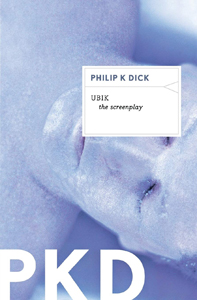The relationship between Philip K. Dick and cinema has mostly been posthumous. Although he saw the “Blade Runner” sets and admired them before his death in 1982, we didn’t get to find out what he thought of the film, or of the dozens of movie and TV adaptations of his work since then.
Stepping into a new medium
But PKD himself did have one notable brush with cinema: He wrote a screenplay for his 1969 novel “Ubik” in 1974. The film didn’t come close to being made, but the script was published in 1985. As one would expect, it’s a faithful adaptation. The dialog is mostly word-for-word, which makes sense as Dick’s characters speak overly literally to begin with – although it does put a challenge on the actors to make the words sound natural.
PKD’s emphasis on music carries from novel to screenplay as he gives stage directions for the diegetic music at the Zurich half-life funeral home early in the book. He also gives a fair amount of stylistic directions, such as fade-outs, and some set design notes. He imagines sets will look like the “Star Trek” TV show, so perhaps it’s good that his books don’t usually include location details.

“Ubik: The Screenplay” (1985)
Composition year: 1974
Writer: Philip K. Dick
Genre: Science fiction
Settings: Switzerland, New York and Iowa; the future of 1992 and (seemingly) 1939
Dick describes psi tester Joe Chip and his boss, Glen Runciter, and some other characters in detail. But, weirdly, he doesn’t have much to say about Pat Conley and Wendy Wright, the rival female leads who form a rather depressing love triangle with Joe. Pat basically hates him, and Wendy is the first to die. Still, actresses could give these women presence.
I briefly thought “Ubik” has too many characters, but what the heck, a big group of anti-psis allows for casting of amusing character actors. Plus, this is sort of like a horror film as people get picked off one by one by a mysterious force, so the more the merrier.
Ubiquitous Ubik
“Ubik” is one of PKD’s best books, as he follows his wild ideas to the end, rather than abandoning one idea when another strikes his fancy. The ideas – psis and anti-psis, half-life and rebirth after death, time reversion, and a life-restoring product that comes in many forms — fit together while leaving room for both laughs and interpretation.
In the screenplay, PKD often abruptly interrupts the action – sometimes in the middle of a conversation – when a spray can of Ubik, painted in the realistic style of Andy Warhol, suddenly takes over the screen. (In the book, he puts funny little Ubik product ads at the start of each chapter.)
This strikes me as unsubtle and unappealingly jarring. There’s an opportunity here to do something like “Under the Silver Lake”: Pepper Ubik spray cans and other Ubik products into the background, and perhaps have them double as clues to what’s really going on.

Which weird explanation is right?
In both the novel and the screenplay, PKD guides us through possible explanations for the weirdness. First, it seems Pat Conley is using her power to jump everyone in her sphere back in time at various intervals till they’ve gone from the future of 1992 back to 1939.
Then it seems that rather than Runciter being dead, he is the sole survivor of the bomb and everyone else is dead, and continuing on in half-life cold-pac. Jory, the antagonist, rules (and indeed creates) the cold-pac world at the Zurich funeral home, but every object entropically reverts so time appears to be receding.
Ella Runciter (whose rebirth arc is expanded in the screenplay) has influence on Jory’s world, as does her husband from the outside, although he’s mostly limited to verbal or written communications. Ubik spray cans give Joe and others extra energy to fend off Jory, who is essentially a soul vampire, like in “Doctor Sleep.” Granted, Jory is crazy, but he has little reason to create money with Runciter’s face on it. So that’s an argument for substantial influence by Ella and/or Glen.
Finally, in an epilog, we get the controversial scene where the supposedly alive Runciter sees coins with Joe Chip’s face on them. This suggests the originally presented possibility was true all along: that Runciter is dead and in cold-pac and Joe and the others survived.
By extension, that means real reality has been receding, a chilling idea to us all, and one that particularly bothered Dick. The author said, for instance, that his short story “The Electric Ant” – where reality changes to nothingness (because that’s the natural state) – creeped him out.
A multi-layered brainteaser
Because of “Ubik’s” ambiguity about which reality is real, a filmmaker could pepper clues into the background – along with, or in relation to, the Ubik products – that would allow an attentive viewer to determine which of the possible situations is true.
They might manage to have us look at the book in a new way, because Dick includes a few inexplicable moments. For instance, consider the explosion in the hotel lobby. In the moment, Joe accuses Pat, but later it’s clear she didn’t cause the explosion. Yet Dick doesn’t explain it; this might be an opening for the film to have some fun.
Unfortunately, even with PKD still being a sellable brand, it’s unlikely “Ubik” will be made. For one thing, its big hook is the reveal of a “Matrix”-like world where our main characters are actually energy sources rather than people with agency. As we know from “Matrix Resurrections,” SF brain-benders aren’t popular at the moment.
And with the period settings needed to sell the shock of time reversion, “Ubik” couldn’t properly be made on the cheap. If it is made, it’s unlikely a filmmaker would be willing to shoot PKD’s screenplay straight up (or close to it), minimizing their own influence for the sake of giving fans a movie that comes (almost) directly from Dick.
For now, it’s fun to read the screenplay. While the novel’s details – Joe’s sad-sack inner monologs and theorizing in particular — make it superior, Dick moves the bulk of “Ubik” to screenplay form in a workmanlike yet thoughtful manner. With the deft hand of a filmmaker who understands PKD, there might be a good movie in here.

